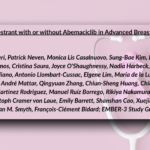
Clinicians and researchers continue to seek targeted treatment strategies for EGFR-mutant non-small cell lung cancer (NSCLC), with an increasing number of clinical trials evaluating combination therapies. Two recent high-profile studies, the FLAURA-2 and MARIPOSA trials, have led to the FDA approval of new first-line treatment options for EGFR-mutant NSCLC in 2024.The FLAURA-2 and MARIPOSA trials explored two different combination treatment approaches. FLAURA-2 evaluated osimertinib plus platinum-based chemotherapy compared to osimertinib monotherapy, while MARIPOSA investigated amivantamab plus lazertinib versus osimertinib alone. Both studies demonstrated improvements in progression-free survival (PFS) with combination therapies in the first-line setting. Moreover, a recent press release indicated that MARIPOSA’s amivantamab-lazertinib combination improved overall survival (OS) compared to osimertinib alone, although mature data have not yet been disclosed. FLAURA-2 also showed a trend toward OS improvement with osimertinib plus chemotherapy over monotherapy.
Dr. Susan Scott, a thoracic medical oncologist at Johns Hopkins Sidney Kimmel Comprehensive Cancer Center and assistant professor of oncology at Johns Hopkins University School of Medicine, commented: “Of course, the possibility of improving OS is exciting news for both patients and healthcare providers. How FLAURA-2 and MARIPOSA will be integrated into clinical practice remains to be seen.”
While both the FLAURA-2 and MARIPOSA regimens demonstrated advantages over osimertinib monotherapy, they have distinct characteristics. Since there has been no direct comparison between the two regimens, it is still unclear which patients would benefit the most from each approach. Some patients may be more interested in or derive greater benefit from amivantamab-lazertinib, while others may respond better to osimertinib plus chemotherapy. Dr. Scott emphasized the importance of analyzing additional data to identify the optimal combination therapy for high-risk patients and expressed hope for more clarity in the coming years. She stated, “Having more treatment options is always beneficial, and I strongly believe that therapy should be a personalized decision. Choosing one regimen over another depends on a patient’s preferences, the additional risks associated with combination therapy, and the specific characteristics of the disease.”
How Should Physicians Choose Among the Three First-Line Strategies for EGFR-Mutant NSCLC?
The latest findings from FLAURA-2 and MARIPOSA raise the question of whether osimertinib monotherapy is becoming obsolete. Dr. Scott does not believe that is necessarily the case. The choice of treatment largely depends on the patient’s preferences, treatment goals, and logistical considerations. When treating newly diagnosed EGFR-mutant NSCLC patients, she evaluates all three available first-line options.
While the FLAURA-2 and MARIPOSA combination therapies show promising efficacy, further research is needed to identify patients who can safely receive osimertinib monotherapy. For those with low-risk disease features, or patients reluctant to accept the added toxicity and risks associated with combination therapy, osimertinib monotherapy remains an appropriate option.
In clinical practice, Dr. Scott is increasingly considering combination therapies, especially for patients with brain metastases, detectable ctDNA at diagnosis, high tumor burden, or severe symptoms.
Each new drug comes with additional side effects. The amivantamab-lazertinib combination is likely to have more adverse effects than osimertinib alone. The choice of a first-line treatment regimen for EGFR-mutant NSCLC should balance treatment risks against expected benefits, while considering both patient and disease characteristics, as well as individual treatment goals and preferences.
Since both FLAURA-2 and MARIPOSA regimens have now been approved for first-line use, further research is necessary to directly compare these two combination approaches. Future studies should focus on precision evaluations in high-risk patient subgroups, further distinguishing the characteristics and advantages of each regimen.
The continuous evolution of combination therapies provides more personalized options for patients with advanced EGFR-mutant NSCLC. In the coming years, accumulating real-world data and clinical experience with these therapies will further refine treatment decisions and optimize patient outcomes.


